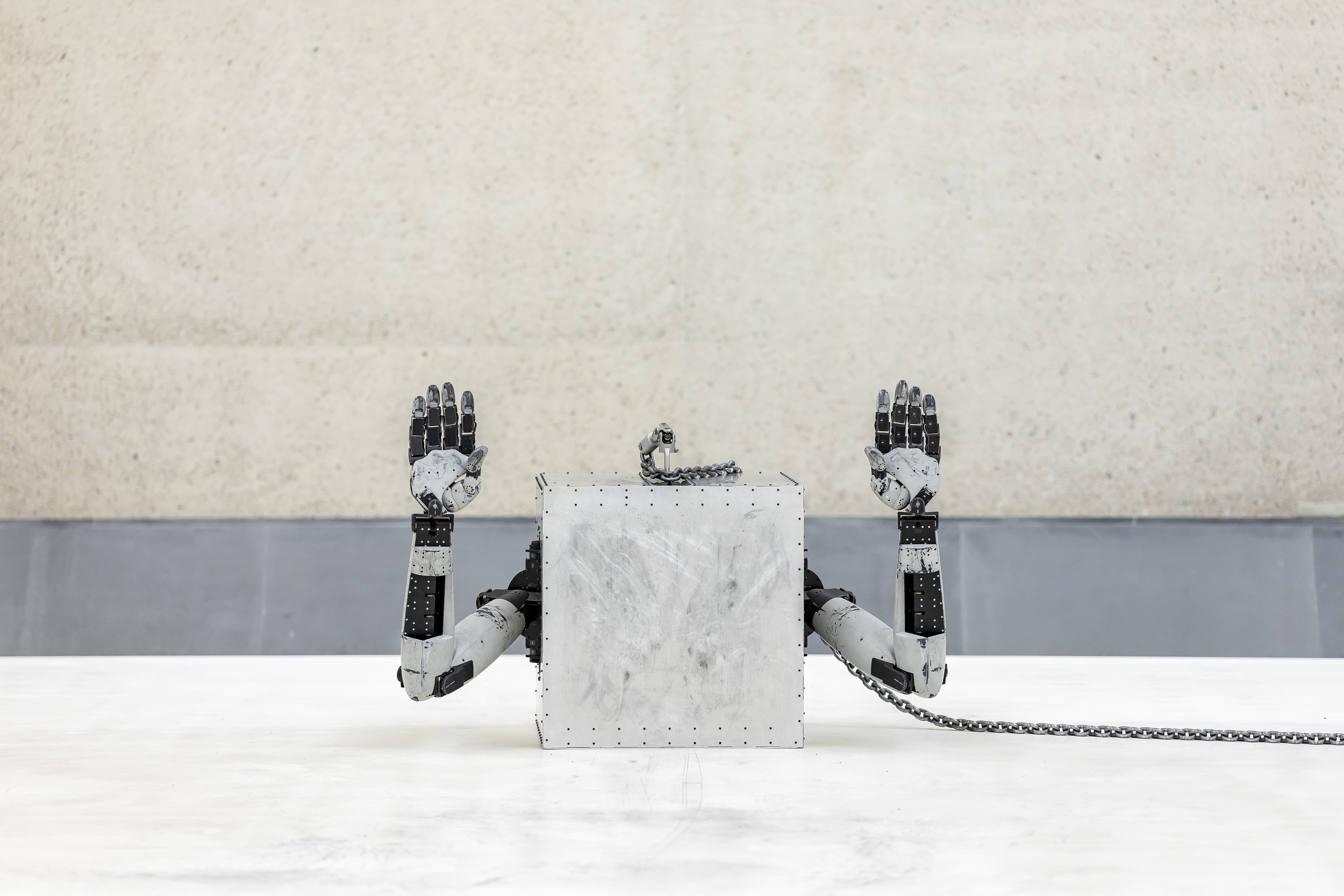The body that holds us: Jordan Wolfson’s ‘Body Sculpture’ at the National Gallery of Australia
/Deep within the brutalist confines of the National Gallery of Australia (NGA), an anticipated new artwork is unveiled. Commissioned in 2019 for the NGA’s permanent collection, Body Sculpture (2023) is an animatronic sculpture by prolific American artist Jordan Wolfson. Branded an enfant terrible early on in his career, Wolfson, now 43 years old, has seemingly entered a new phase, one defined less by transgression and more by abstraction.
Body Sculpture blends person and object, minimalism and figuration, art and technology, and compels viewers to experience their own bodies and the consciousness it houses. The third in Wolfson’s series of animatronic sculptures after Female Figure (2014) and Colored Sculpture (2016), Body Sculpture is formally innovative and tonally distinct, squarely engaging with human practices such as introspection, spirituality, and, at times, agonizing cogitation. Not since Callum Morton’s Reception (2016), a sculptural installation featuring a robotic facsimile of Melbourne art dealer Anna Schwartz, has an animatronic artwork exhibited in Australia generated such interest. Like Morton’s work, Body Sculpture is capable of eliciting decidedly human responses including sadness, elation, and dread.
The NGA provides an atypical context for Body Sculpture’s inauguration. Despite being somewhat removed from the global contemporary art hubs of New York and London, Kamberri/Canberra and the NGA can provide the space, time, and resources for Wolfson’s ambitious sculpture to be realised, experienced, and maintained. The issue of cost has been the subject of debate since the commission was first announced, with some suggesting it was unwise for the NGA to make the reported $6.67 million investment, despite the potential upside. The debut of Female Figure for instance, saw people queuing for hours outside David Zwirner in Manhattan’s Chelsea neighbourhood. It will be interesting to see whether any snaking lines start to form within the Parliamentary Triangle.
As is typical of Wolfson’s work, meaning is undefined and is constructed by numerous formal elements and signifiers. Stripped of the pop-cultural associations of Female Figure and Colored Sculpture (including references to Alfred E. Neuman, Lady Gaga and Huckleberry Finn), Body Sculpture is ostensibly minimal by comparison. Despite the sculpture encompassing several mechanisms, a central 36-square-inch metal cube assumes the role of protagonist; its consciousness conjured by two jutting arms. Over approximately 25 minutes, the Judd-like cube and its extremities are manipulated by an additional robotic appendage wielding a leaden chain. Framed by an immense steel gantry, the cube performs a sequence of precise movements across three acts. Underpinned by a firm rhythmic quality, tender signs of prayer, meditation and self-care give way to motions conveying sensuality and playfulness, which evolve into a series of intensely sexual gestures before cutting to a stark expression of unfathomable shame. Body Sculpture culminates in simulations of violence, ferocity, and intractable rage as the sculpture thrashes wildly until, finally, it prepares to stage a suicidal action. The artwork is abundantly beautiful and incredibly sad.
The technological sophistication of Body Sculpture facilitates the profound emotional capacity of what is, in essence, a faceless aluminium cube. It is important to highlight the rigorous collaborative processes that underpin Body Sculpture and allow for the artwork’s conscious faculty to be realised. Roboticist, artist, and software engineer Mark Setrakian, known for his work on films including How the Grinch Stole Christmas (2000), Hellboy (2004), and Men in Black (1997), is Wolfson’s longstanding principle collaborator. Other notable consultants on Body Sculpture include composer and percussionist Eli Keszler, clown expert Stefan Haves, and choreographers including Adam Linder, Daphne Fernberger, and Irme and Marne van Opstal.
Whether or not Body Sculpture acts as a proxy for its audience, the elusive beauty of its scraped surfaces engages with broader notions of erosion and decay, acknowledging the constant abrasion of the body that holds us. Wolfson allows Body Sculpture to be scarred by the detritus of life, inviting audiences to hold communion with the affected artwork and, in turn, with themselves.
Yarran Gatsby, Kamberri/Canberra
Curated by Russell Storer, ‘Jordan Wolfson: Body Sculpture’ is on display at the National Gallery of Australia until 28 April 2024. Jordan Wolfson lives in Los Angeles and is represented by David Zwirner, Gagosian, and Sadie Coles HQ.






















